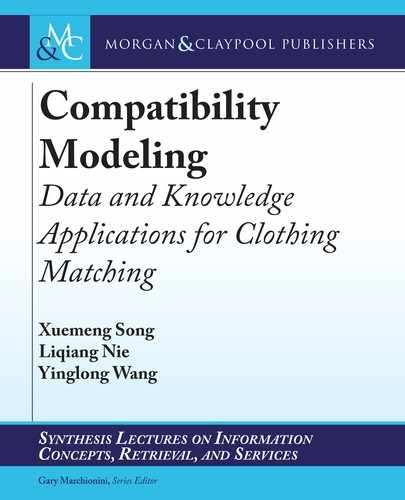
xvii
Preface
Undoubtedly, clothing plays an essential role in people’s daily life, as a proper outfit can greatly
empower one’s favorable impression. As each outfit usually involves multiple complementary
items, such as top, bottom, shoes, and accessories, to a great extent, the key to a proper outfit
lies in harmonious clothing matching. However, not everyone is a natural-born fashion stylist,
which makes choosing compatible clothes a tedious and even annoying daily routine. It thus
deserves our attention to develop an effective clothing matching scheme to help people find
the suitable match for a given item and make a proper outfit. anks to the proliferation of
online fashion-oriented communities, such as IQON and Chictopia, as well as e-commerce
sites, such as Amazon and eBay, where a tremendous amount of rich real-world data regarding
users’ shopping, reviewing, and coordinating behaviors on fashion items have been accumulated,
researchers are able to investigate the code in clothing matching.
In a sense, the problem of clothing matching posed here primarily requires modeling
the human notion of the compatibility between fashion items. Despite its significant value,
compatibility modeling for clothing matching that involves not only a large number of feature
variables but also complicated factors such as the domain knowledge and user factor, suffers from
the following tough challenges:
(a) Absence of comprehensive benchmark. How can we construct comprehensive datasets
to facilitate the validation of compatibility models?
(b) Comprehensive modeling. Existing studies mainly focused on measuring the com-
patibility based on visual images of items but failed to take their contextual information
into account. Accordingly, the comprehensive compatibility modeling with multi-modal
feature variables is largely untapped.
(c) Knowledge incorporation. As an integral part of people’s daily life, clothing matching
domain has accumulated valuable knowledge. How to utilize domain knowledge to guide
machine learning is another challenge we are facing.
(d) Interpretability enhancement. A realistic compatibility modeling scheme should not
only give the final decision on whether the given fashion items are compatible or not, but
also provide the underlying reasons. How to enhance the interpretability of the compati-
bility modeling constitutes a crucial challenge; and
(e) User factor. e user aesthetics on clothing matching can be subjective due to their dif-
ferent fashion tastes. Meanwhile, user body shapes also affect the compatibility modeling
xviii PREFACE
for clothing matching to a certain extent. ereby, personalized compatibility modeling
should be investigated.
Besides these, several other challenges have been raised, including confidence assignment of
various knowledge rules for clothing matching, user preference modeling, and user body shape
modeling in compatibility modeling.
In fact, the huge economic value of the fashion industry has drawn great attention from
many researchers. Existing efforts mainly focus on tackling the problem of clothing retrieval,
clothing recommendation, and fashionability prediction. However, only a limited number of
studies have been dedicated to the compatibility modeling, not to mention the knowledge-
guided and personalized compatibility modeling, aspects. Noticing this timely opportunity, we
present in this book some state-of-the-art theories on compatibility modeling. In particular,
we first summarize the method of building several comprehensive benchmark datasets, which
have been released to facilitate other researchers. We then introduce how to model the gen-
eral compatibility that can be affected by complicated factors in a pure data-driven manner. To
further boost performance, we next present a novel knowledge-guided compatibility modeling
framework, where a knowledge-encoding method is introduced. ereafter, we enhance the
interpretability of the compatibility modeling scheme with the latent compatible/incompatible
prototype learning. Following that, we extend the general compatibility modeling to a person-
alized one, based on which we further study the real-world application of personalized capsule
wardrobe creation. Finally, we conclude the book and present the future research directions in
the compatibility modeling domain, such as generative compatibility modeling, virtual try-on
with arbitrary poses, and clothing generation.
is book presents preliminary research on fashion compatibility modeling, and we expect
it can evoke active researchers to work on this exciting area. Overall, this book presents an in-
depth introduction to the compatibility modeling problem, by shedding light on the important
research topics and the latest developments in the field. It is suitable for students, researchers,
and practitioners who are interested in the compatibility modeling for clothing matching task.
Notably, although the datasets used in this work may be biased to the female on account that
male users are not as active in online fashion-oriented websites, the theories presented in this
book can be effortlessly applied to male clothing as long as the corresponding data are available.
If in this book we have been able to dream further than others have, it is because we are standing
on the shoulders of giants.
Xuemeng Song, Liqiang Nie, and Yinglong Wang
September 2019
..................Content has been hidden....................
You can't read the all page of ebook, please click here login for view all page.
